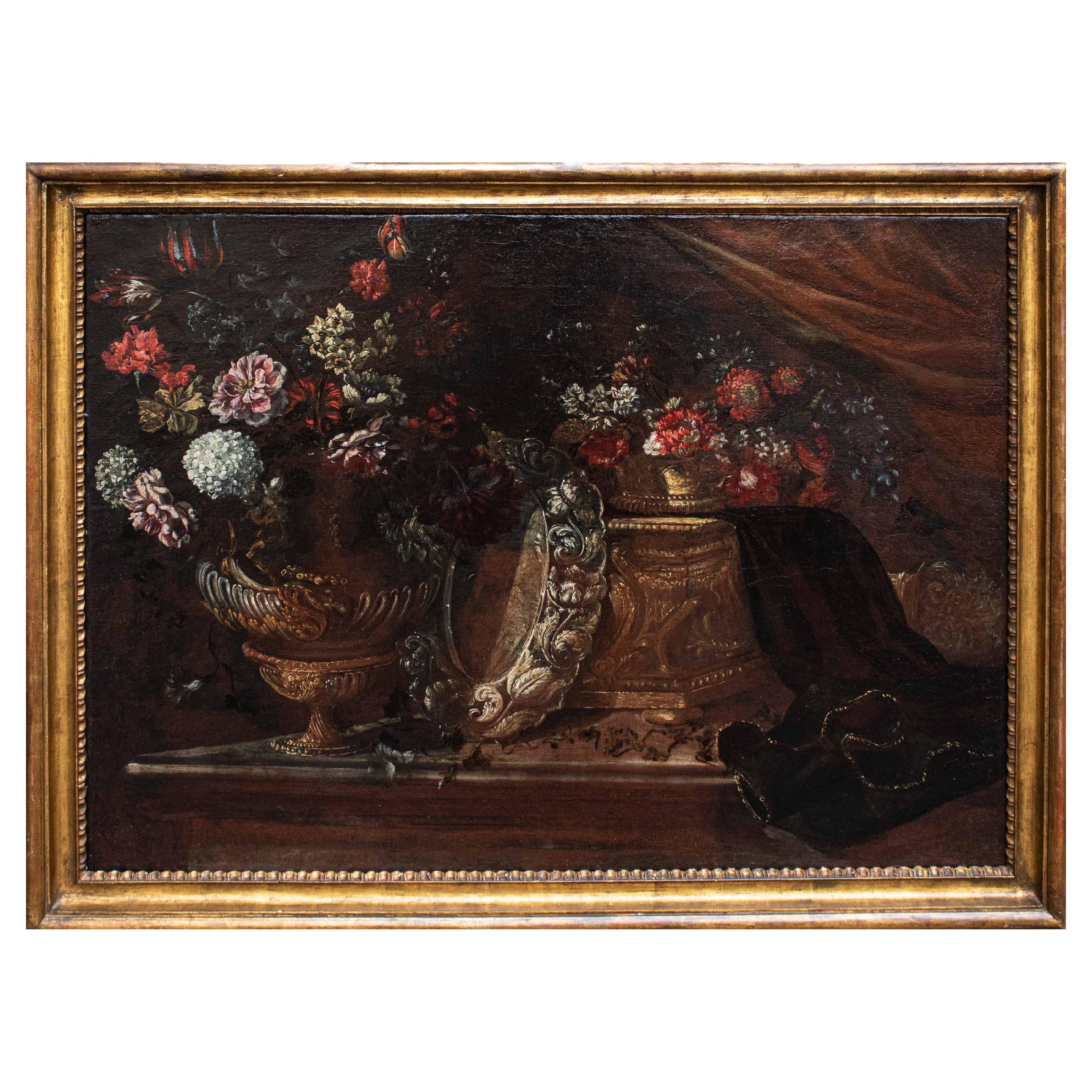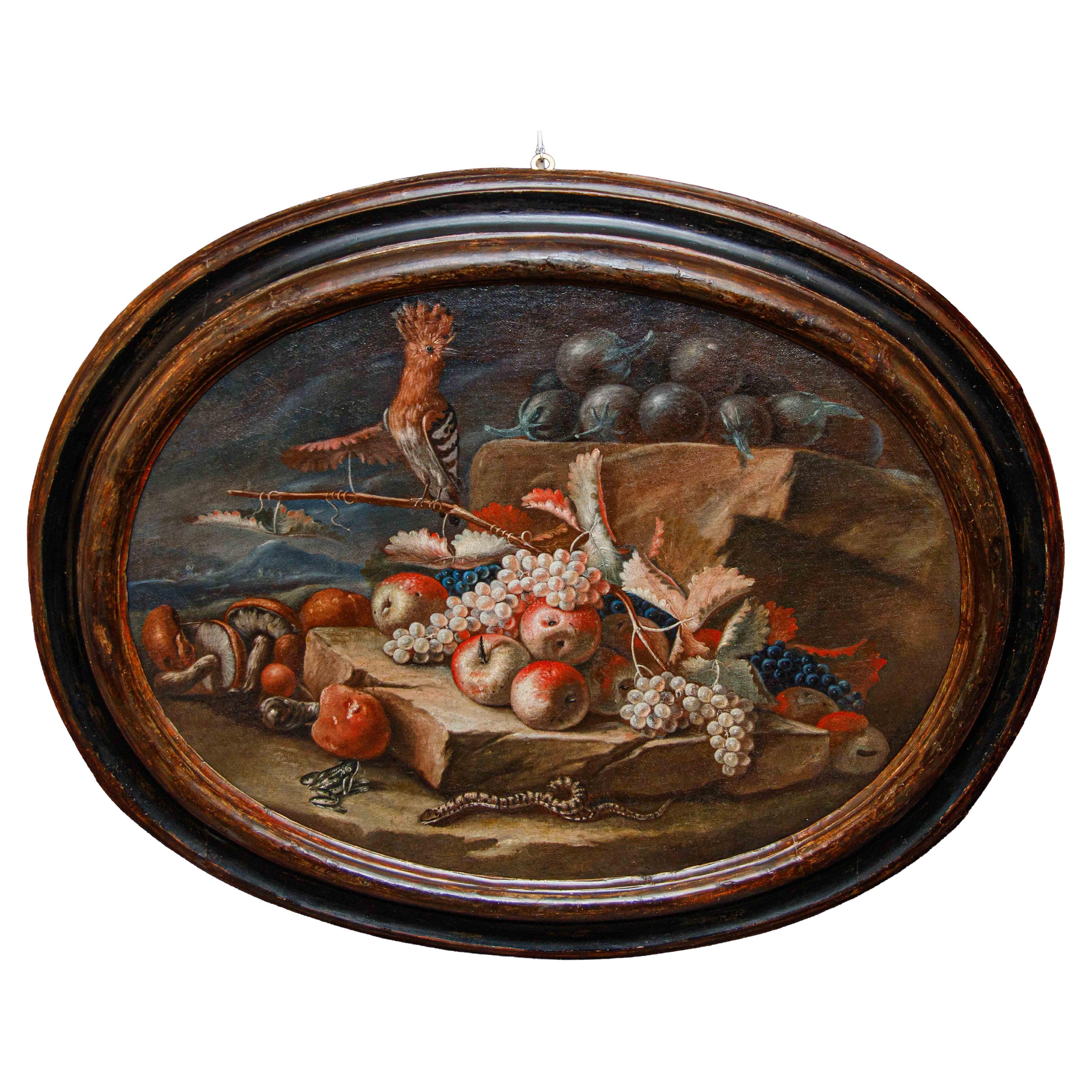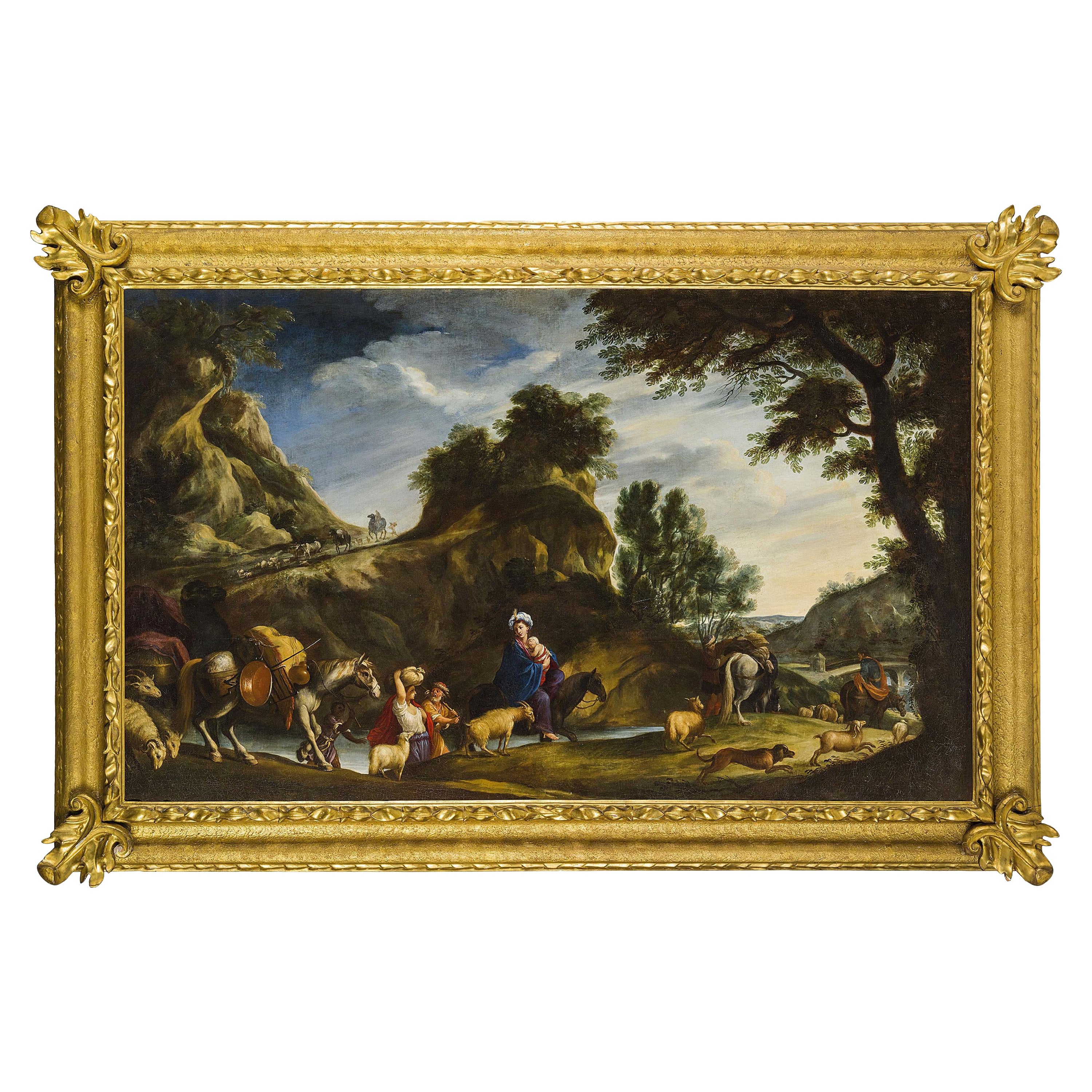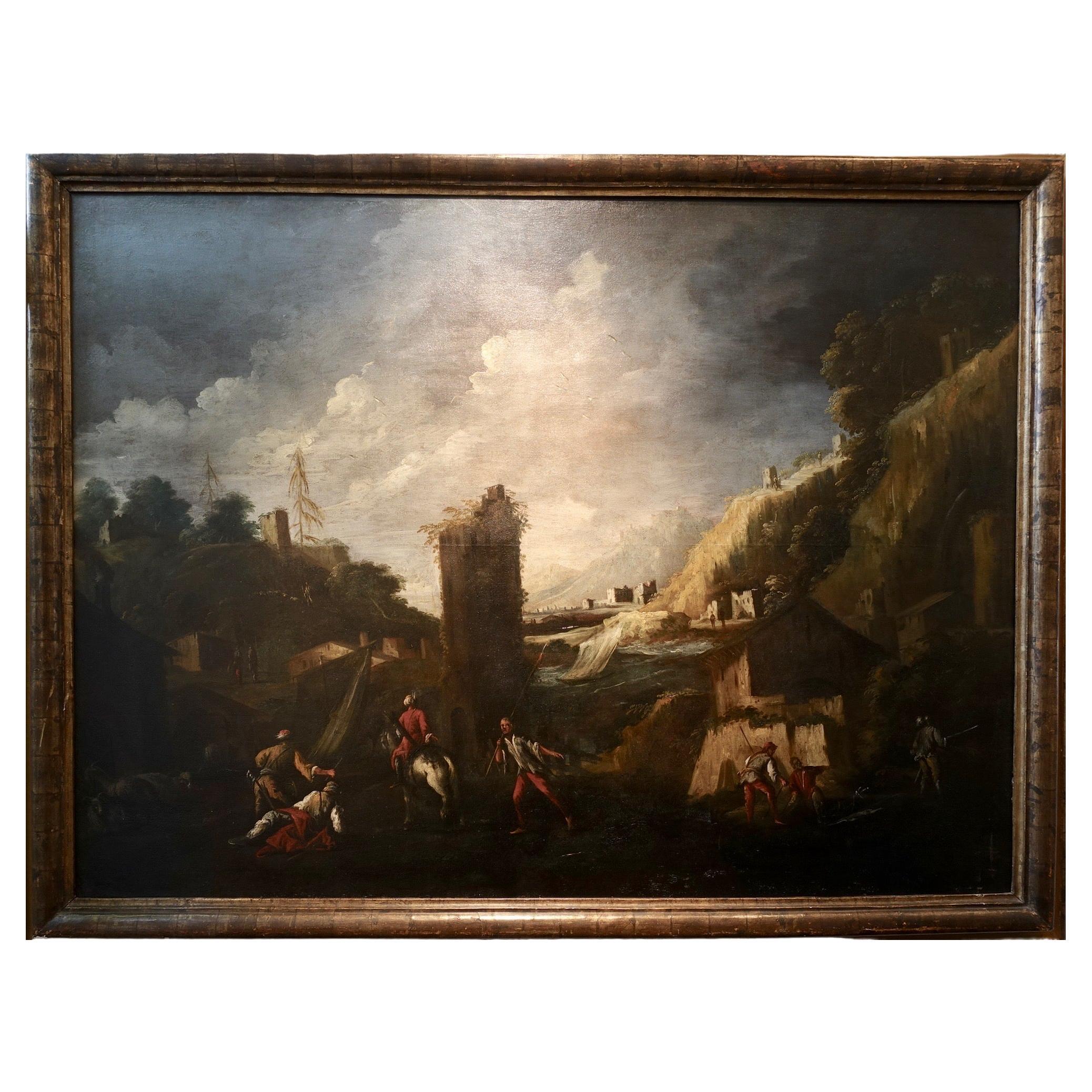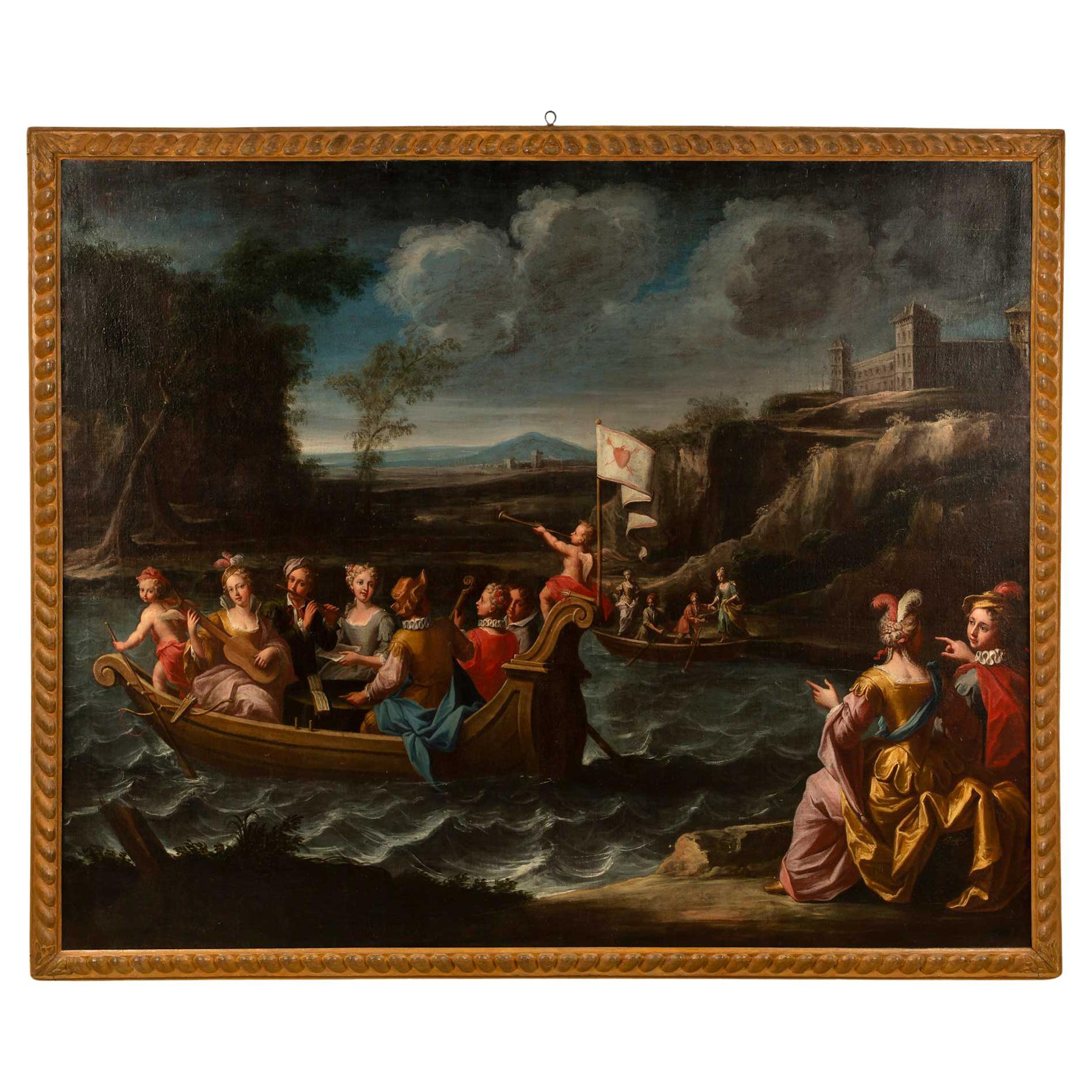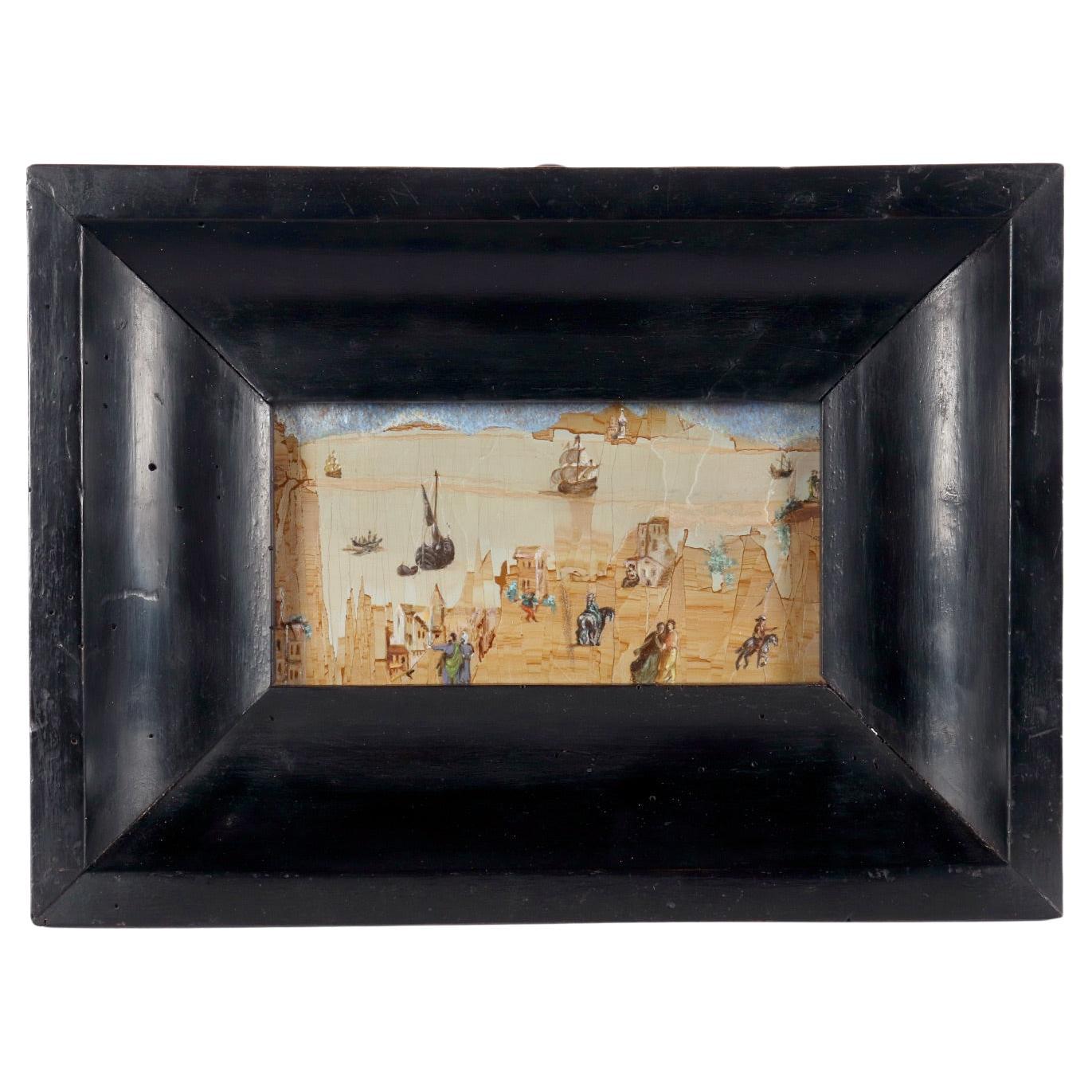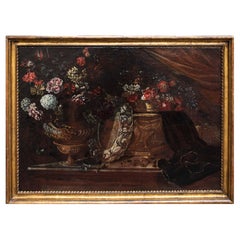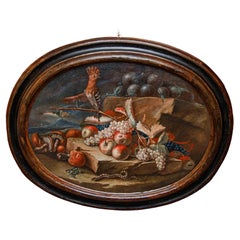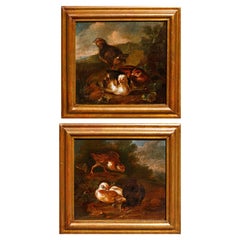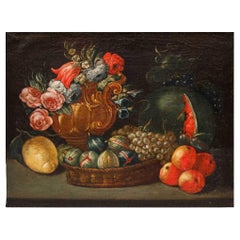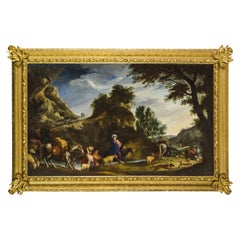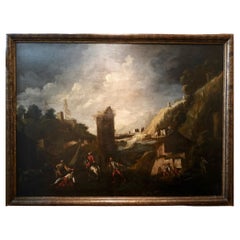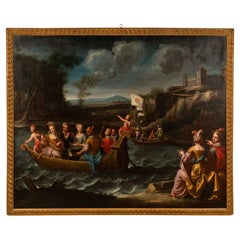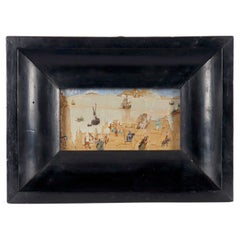Items Similar to 17th century, recco follower, (Naples, 1634- Alicante, 1695), Still Life
Want more images or videos?
Request additional images or videos from the seller
1 of 11
17th century, recco follower, (Naples, 1634- Alicante, 1695), Still Life
$5,519.69
£4,070.56
€4,600
CA$7,622.65
A$8,363.86
CHF 4,377.26
MX$102,930.80
NOK 55,146.86
SEK 51,653.25
DKK 35,034.65
About the Item
17th century, follower of Giuseppe Recco (Naples,1634- Alicante,1695)
Still life of fish, squid, oysters and corals on the beach
Oil on canvas, 57.5 x 117 cm
Framed, cm
On the back of the canvas wax seal and early twentieth-century inventory label bearing the inscription "P.[or]ta / sc.[uola] Sorrento / lot no. 3 / [...] Recco."
This canvas fully pursues the stylistic features of seventeenth-century still life that had Naples as its genre as one of its capitals. Many names distinguished themselves in this type of work, depicting flowers, fruits, musical instruments and animals, including, indeed, fish, mollusks and crustaceans. In this sense Giuseppe Recco was one of the cornerstones of the Neapolitan school, depicting a variety of subjects in his production but with a particular penchant for marine still lifes, later taken up also by his children Elena and Nicola Maria; a pupil of Paolo Porpora and son of the painter Giacomo, Recco devised compositions that set the school within the Neapolitan painting scene, managing, however, to distinguish himself especially in the depiction of marine fauna, as critics and biographers attest, for the vivid and lustrous rendering of the latter that would surpass that of all those who had preceded him. This work echoes his style and compositions in full: the scales of the fish reflecting light, highlighted by a dark setting; the haphazard arrangement; and the variety of species, among which mullet, barracuda, sea bass, big eyes, red corals, grayish squid, and dark-shelled oysters appear. The openness of the seascape background does not contrast with the protagonists in the foreground, and the cloudy sky, together with the misty earth-colored rocks, recreates in a variegated and airy form the completely dark and indoor environments found in other depictions. The tangency with Recco is found in multiple works of his production, especially with the canvas remembered at the Paolo Sapori Gallery in Spoleto; moreover, on the back of the work appears a wax seal and inventory label from the early twentieth century bearing the inscription "P.[or]ta / sc.[uola] Sorrento / lot no. 3 / [...] Recco," which allows this canvas to be associated with absolute certainty with the workshop or followers of the artist who were active during the second half of the seventeenth century.
- Dimensions:Height: 117 in (297.18 cm)Width: 57 in (144.78 cm)Depth: 2 in (5.08 cm)
- Style:Other (In the Style Of)
- Materials and Techniques:Canvas,Oiled
- Place of Origin:
- Period:
- Date of Manufacture:XVII Century
- Condition:Wear consistent with age and use.
- Seller Location:Milan, IT
- Reference Number:1stDibs: LU5918245089892
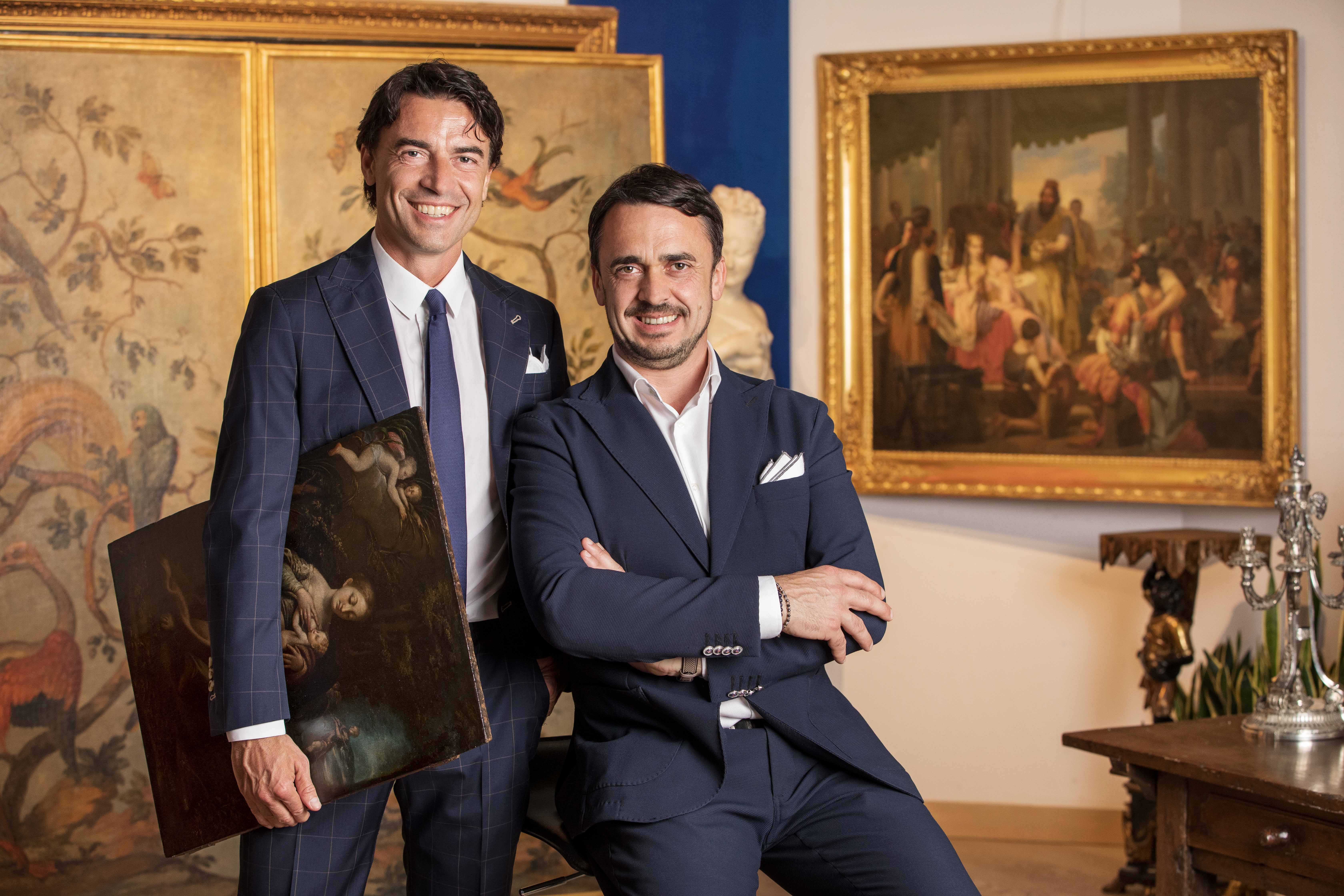
About the Seller
5.0
Vetted Professional Seller
Every seller passes strict standards for authenticity and reliability
Established in 2000
1stDibs seller since 2021
30 sales on 1stDibs
Typical response time: 1 to 2 days
- ShippingRetrieving quote...Shipping from: Milan, Italy
- Return Policy
Authenticity Guarantee
In the unlikely event there’s an issue with an item’s authenticity, contact us within 1 year for a full refund. DetailsMoney-Back Guarantee
If your item is not as described, is damaged in transit, or does not arrive, contact us within 7 days for a full refund. Details24-Hour Cancellation
You have a 24-hour grace period in which to reconsider your purchase, with no questions asked.Vetted Professional Sellers
Our world-class sellers must adhere to strict standards for service and quality, maintaining the integrity of our listings.Price-Match Guarantee
If you find that a seller listed the same item for a lower price elsewhere, we’ll match it.Trusted Global Delivery
Our best-in-class carrier network provides specialized shipping options worldwide, including custom delivery.More From This Seller
View AllOil painting on canvas depicting Still life Roman school of the 17th century
Located in Milan, IT
Roman School, 17th century
Still Life
Oil on canvas, 79 x 107 cm
Framed, 93 x 121 cm
The work under scrutiny, depicting a majestic still life of flowers, is ascribed to the 17th...
Category
Antique 17th Century Paintings
Materials
Canvas
Emilian school, 18th century, Still life with hoopoe, frog and snake
Located in Milan, IT
Emilian school, 18th century
Still life with hoopoe, frog and snake
Oil on oval canvas, 73 x 100 cm
Framed, 98 x 125 cm
The still life in question, which displays various disting...
Category
Antique 18th Century Italian Other Paintings
Materials
Canvas
Emilian school, 18th century, Pair of live natures with birds
Located in Milan, IT
Emilian school, 18th century
Pair of live natures with birds
Oil on canvas, 28 x 30 cm
Framed, 37 x 38.5 cm
The northern Italian school of painting developed, as early as the 16t...
Category
Antique 18th Century and Earlier Italian Other Paintings
Materials
Canvas
19th century, Still life with fruits
Located in Milan, IT
19thC
Still life with fruits
Oil on canvas, 64 x 52 cm
The still life analyzed presents a mixture of floral and fruit elements arranged in a circular order on a table covered with...
Category
Antique 19th Century Italian Other Paintings
Materials
Canvas
Lombard school, 17th century, Still life with flowers
Located in Milan, IT
Lombard School, 17th century
Still Life with Flowers
Oil on canvas, 52 x 60 cm
Framed, 67 x 76 cm
The oil on canvas under consideration, depicting a floral jubilation emerging f...
Category
Antique 17th Century Other Paintings
Materials
Canvas
17th century, Landscape with characters
Located in Milan, IT
XVII Century
Landscape with characters
Oil on canvas, 72 x 92 cm
Framed, 95 x 112 cm
Category
Antique Late 17th Century Dutch Other Paintings
Materials
Canvas
You May Also Like
17th Century, Italian Painting by Pier Francesco Cittadini, Jacob and his Family
Located in IT
Pier Francesco Cittadini (Milan, 1616-Bologna, 1681)
"Jacob and his family go to Egypt"
Oil on canvas, cm 109 x 190 (canvas only)
The valuable painting, made in oil on canvas, depicts Jacob and his family go to Egypt and we believe it can be, given the high quality painting, autograph work of Italian Pier Francesco Cittadini (Italy Milan, 1616 - Bologna, 1681) made after 1647. The work, in excellent condition is accompanied by a coeval frame in wood finely carved and golden.
The scene depicted, which was confused with the Flight to Egypt in the past years, is instead identified with the biblical episode of Jacob’s journey. In the foreground, reading the painting from left to right, we see a caravan composed of animals, including donkeys, dromedaries, goats, dogs and horses and people, women, men and slaves, who carry on their journey along the banks of a river, following a path that to the right, would seem to lead to the through of a bridge. In addition to the watercourse is described an environment characterized by large rocks and impervious come far to cover the entire verticality of the canvas. On the left, in the distance, we see the tail of the caravan that runs along the steep path. Large trees enliven and harmonize the environment, as well as white and grey clouds characterize the predominantly clear sky and illuminated on the right by sunlight.
The story is told in the Bible, Book of Genesis, 30, 25, passage in which is described the flight of Jacob from Haran after the contrasts with Laban, father of his wife Rachel. Jacob is the third great patriarch of the Bible. From his descendants originate the twelve generations of the people of Israel. He is the son of Isaac and Rebekah, who led him to flee from the wrath of Esau to Haran to seek refuge from his brother, Laban. At his uncle’s house Jacob met his daughter Rachel. As soon as he saw his cousin, Jacob was taken. Jacob will stay seven years in the service of Laban to marry his beloved Rachel. But Laban, with a deception, will give him in marriage first Lia, the least beautiful eldest daughter, and only after another seven years the splendid Rachel. From his first wife he will have several children, while Rachel will give birth to the beloved son, Joseph, who will become viceroy of Egypt.
After years of service, Jacob asked to be paid with every dark-coloured garment among the sheep and every spotted and dotted garment among the goats. Laban accepted and sent away from his sons all the leaders of that kind. So Jacob took fresh branches of poplar, almond and plane tree, and flayed them, and put them in the troughs. The optical suggestion induced the goats and the sheep to conceive and give birth to dark, striped and dotted garments. He also ensured that all the strongest and healthiest leaders of the flock of Laban would drink near the barked branches, thus assuring a genetic superiority to his part of the flock. His flocks grew numerous and strong and he became richer than his relative, arousing envy. It was clear that Laban would not respect him much longer. At the suggestion of the Lord, Jacob decided to return to Canaan. Trying to avoid any possible dispute, he left with his family while Laban was absent for shearing sheep. But when, three days later, his uncle returned home, he became angry, feeling offended because Jacob had gone secretly and had not allowed him to greet his daughters and grandchildren. In addition, his teraphim, statuettes, or idols, which depicted the family deities, had disappeared. After 7 days of pursuit, Laban and his men reached Jacob’s group on Mount Gilead, in the mountainous region west of the Euphrates River, where his uncle and grandson had a stormy conversation. The younger man was outraged at being accused of stealing idols and told Labano to rummage through his family’s tents at will. Neither of them could know or even imagine that it was Rachel who took the idols and hid them in the saddle of the camel. During the search, she sat down firmly on the saddle, apologizing for not being able to get up, «because I usually have what happens to women» (Gen 31:35). So the loot wasn’t discovered.
The author of this work was inspired by the composition of an engraving by Stefano Della Bella (1610-1664) of circa 1647. The engraving by Stefano della Bella bears the title "Iacob sur ses vieux jours quitte sans fascherie pour voir son filz Ioseph, sa terre et sa patrie" and is signed on the bottom left "Stef. of the Beautiful In. et fe." while on the right it is declared "Cum privil. Regis", that is with license of the king.
Stefano Della Bella (Italy - Florence, May 18, 1610-Florence, July 12, 1664) was born in a family of painters, sculptors and goldsmiths and was left early orphan of his father sculptor, he dedicated himself first to the art of goldsmith at the school of Giovanni Benedetto Castiglione and Gasparo Mola, then turning his attention to drawing and engraving. He soon began drawing figures and copying the etchings of Jacques Callot, which inspired his early works. Under the protection of the Medici, in particular of Don Lorenzo, cadet son of Grand Duke Ferdinand I, Della Bella has the opportunity to make study trips to Rome, where he stayed from 1633-1636; In Rome he met French engravers and publishers of prints such as Israël Henriet and François Langlois, who influenced his decision to move to Paris in 1639, four years after the death of Callot. In Paris he soon reached, thanks to the engravings commissioned by Cardinal Richelieu, the success also worldly; he frequented courtiers, theatre artists and writers, while refusing too oppressive honors. In 1646-1647 he continued his travels in the Netherlands to Amsterdam, Antwerp and Dordrecht. He returned to Florence in 1650 and resumed working under the protection of the Medici court, working for his patrons. In 1656 he became a member of the Academy of Apatists.
The painting object of this study is reasonably attributable to Pier Francesco Cittadini, or Pierfrancesco Cittadini, called the Milanese or the Franceschino (Italy - Milan, 1616-Bologna, 1681) as some exemplary stylistic comparisons proposed to follow can prove.
Pier Francesco Cittadini was an Italian baroque painter, mainly active in Bologna.
His artistic training first took place with the painter Daniele Crespi...
Category
Antique Mid-17th Century European Baroque Paintings
Materials
Canvas, Giltwood
Antonio Travi Called Le Sestri, Seascape with Ruins, Genoa 17th Century
Located in Bruxelles, BE
Antonio Travi called Le Sestri (Sestri Ponente, 1608 - Genova 1665)
Seascape with ruins
Genova, First half of 17th century
Oil on canvas with his original 17th century frame
M...
Category
Antique 17th Century Italian Baroque Paintings
Materials
Canvas
Italian 18th Century Oil on Canvas from the Piedmont Region
Located in West Palm Beach, FL
A sensational and large scale Italian 18th century oil on canvas from the Piedmont region. The beautiful painting is set in its original polychrome frame which displays a lovely carv...
Category
Antique 18th Century Italian Paintings
Materials
Canvas, Wood
An oil genre painting on Paesina, Italy end of 18th century.
Located in Milan, IT
An oil painting on Paesina stone. The frame, made of ebonized walnut wood finished in wax, has a rectangular shape with an internal molding that flares out towards the inside to acco...
Category
Antique Late 18th Century Italian Paintings
Materials
Stone
Daniel Cletcher 17th Century Painting Oil on Wood Panel 1628 Den Haag Flemish
Located in Münster, DE
A landscape with nymphs and satyrs revelling by a stream , 1628
Daniël Cletcher, Den Haag 1599
Died: Den Haag buried on 1632-11-25
Father: Thomas Cletcher sr. (? - ca. 1655)
Mother...
Category
Antique 1620s Dutch Baroque Paintings
Materials
Wood
18th Century, Venetian School Italian Landscape Oversize Painting
Located in Milano, MI
Early 18th century Italian Venetian inland painting, a large size oil on canvas Baroque mountain landscape with stream, bridge, waterfall, wayfarers and a village in the background. The woodland is animated by figures, a caravan with horsemen fishermen. This monumental Italian Baroque landscape painting has a strong impact and an excellent composition balance, as it depicts in the center the luminous perspective of a fortified village, whose side wings consist of two mountain rocks with dark wooded vegetation crowded by characters, horsemen, paths, streams.On the left side, with respect to the observer, there is a path that runs alongside a stream that flows into a waterfall in the center of the composition. from a caravan of travelers on foot and on horseback traveling along it in both directions: going up the slope on the mountainous coast you can see a church and a village near the top. The right part of the painting depicts a more sparse and dry vegetation, painted in the chromatic tones of ocher, inside of which there are dead plant, dry branches and a smaller number of figures on the rugged mountain. The iconographic inspiration of this wooded representation seems to be in the large trunk of the withered conifer in a central position, which represents a dead tree, as a? reminder of the transience of everything in life, whose phases are summarized in the two mountainous coasts. In the background a village painted in light and soft blue colors, in stark contrast to the previous scene, seems to reassure and project us into a future season.
With a suggestive theatrical effect, more than 250 cm wide, this Baroque Italian painting comes from a private collection of Milan, the canvas has been lined and shows minor painting retouches at a horizontal seam of the canvas. It is unframed, it has just a wooden profile covering the canvas edge.
It is an antique Italian landscape, the perfect opportunity to make a statement. Get the perfect size painting for a great living room, to create that eye-catching focal point. You can make an impact with a single large work by hanging this early 18th century Italian Baroque painting...
Category
Antique Early 18th Century Italian Baroque Paintings
Materials
Canvas
$23,887 Sale Price
20% Off
More Ways To Browse
La Bottega
Dove Figurine
Edwardian Perfume Bottles
French Upholstered Beds
Nest Magazine
Oak Letter Box
Olive Burlwood
Outdoor Metal Springer Chair
Owl Bank
Pair Of Chinese Parrots
Parlour Cabinet
Phantom Lamp
Pierre Rosenberg
Pink Glass Boxes
Plan Chest Vintage
Plan Chests Vintage
Plaster Relief Panel
Plinth Dresser
